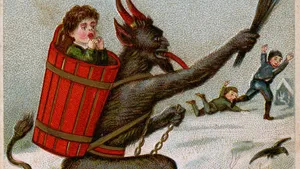Krampus

January 6, 2023
Krampus is a horned, anthropomorphic figure in the Central and Eastern Alpine folklore of Europe who, during the Advent season, scares children who have misbehaved. Assisting Saint Nicholas, or Santa Claus, the pair visit children on the night of 5 December, with Saint Nicholas rewarding the well-behaved children with modest gifts such as oranges, dried fruit, walnuts, and chocolate, while the badly behaved ones only receive punishment from Krampus with birch rods. The origin of the figure is unclear, as some folklorists and anthropologists have postulated it as having pre-Christian origins.
Although Krampus appears in many variations, most share some common physical characteristics. He is hairy, usually brown or black, and has the cloven hooves and horns of a goat. His long, pointed tongue lolls out, and he has fangs. Krampus carries chains, thought to symbolize the binding of the Devil by the Christian Church. He thrashes the chains for dramatic effect. The chains are sometimes accompanied by bells of various sizes. Sometimes Krampus appears with a sack or a basket strapped to his back, this is to cart off evil children for drowning, eating, or transport to Hell. Some of the older versions make mention of naughty children being put in the bag and taken away.
The Feast of St. Nicholas is celebrated in parts of Europe on 6 December. On the preceding evening of 5 December, Krampus Night or Krampusnacht, the wicked hairy devil appears on the streets. Sometimes accompanying St. Nicholas and sometimes on his own, Krampus visits homes and businesses. The Saint usually appears in the Eastern Rite vestments of a bishop, and he carries a golden ceremonial staff. Unlike North American versions of Santa Claus, in these celebrations, Saint Nicholas concerns himself only with the good children, while Krampus is responsible for the bad. Nicholas dispenses gifts, while Krampus supplies coal and the Rute.


